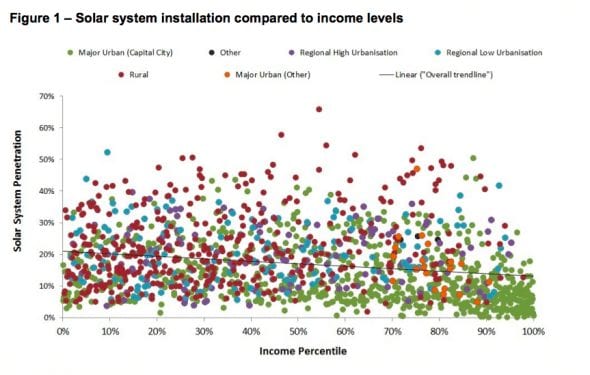Is rooftop solar really just for the rich and comfortably well off, as its detractors would have everyone believe? Or is it, as some in the industry suggest, already approaching mass market commodity?
It’s a question RenewEconomy sought to address in July, using data from the US, which pointed to the fact that rooftop PV had moved well beyond the niche markets of technology enthusiasts and the upwardly mobile. It found that the average income of solar households in the US was just $US57,000, thanks to the solar leasing model which dominates sale in that country, and allows installations for no up front payment.
Anecdotal evidence suggested the same thing was occurring in Australia – despite some utilities successfully convincing federal and state politicians on both sides of the fence otherwise. Now, analysis from the REC Agents Association provides some pretty conclusive evidence that rooftop solar is proving more popular in struggle street than it does in the boulevards of affluent suburbs.
The RAA – in its submission to the Climate Change Authority’s review of the Renewable Energy Target, says just over half of the 1.48 million solar systems (both PV and solar hot water) installed in Australia are located in regional and rural communities. And in the capital cities, the suburbs with the highest penetration were typically in the out metropolitan mortgage belt.
It noted that the average income of the most popular areas in regional areas was between $43,000 and $49,000. The suburbs with the highest penetration in the cities had an average income of $69,000.
“A broad range of communities have accessed solar under the RET scheme and the … figures explode the myth that the RET is supporting metropolitan middle class welfare,” the RAA submission says.
This table below illustrates its findings.
The RAA analysis also found that the suburbs with the highest income levels did not correspond to those with highest penetration. If anything, the opposite was more likely.
“Solar penetration has been higher in those suburbs with lower incomes,” it says. “In terms of solar system installations in capital cities, wealthy inner suburban suburbs are under-represented …. the (small scale renewable energy scheme) SRES is clearly delivering a clear equitable return to those suburbs by enabling them to reduce their exposure to rising electricity prices.
It would be good if politicians understood this, rather than railroaded and snowballed by networks and energy retailers seeking to protect their own business models, despite their protestations that they are here to save the consumer. As we pointed out in this article, the falling upfront cost of rooftop solar – courtesy of cheap modules and innovative financing – could be a big issue in an election campaign focused on cost of living.
This graph illustrates the point.
The RAA also provided further data which debunks some of the myths about rooftop solar. These are useful to repeat, because as Bill Clinton told the US solar industry last week, the biggest challenge is to make politicians, and the general public, aware of the facts.
Some of these statistics include:
– Around 18 per cent of Australian families now have solar systems. For PV, it is roughly one in ten, although in South Australia, the state with the highest penetration, it is one in five.
– Up to 2,200MW of solar PV will be installed by the end of 2012.
– Solar PV and solar hot water systems accounted for nearly half of the 3.2 per cent reduction in electricity consumption on the National Electricity Market since 2008, delivering both environmental and economic benefits to the Australian public.
– This lower level of consumption helped wholesale power prices to their lowest levels in more than 10 years, and will reduce peak power consumption, in turn lowering network investments and costs to the public.
– The solar industry currently employs approximately 25,000 people driving an investment in skills from the installation and manufacture through to the financing of such systems.










